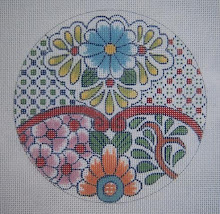 I usually create plaids by just fooling around with bands of color on scrap canvas - or by imitating plaids I see in magazines or on people at the supermarket.
I usually create plaids by just fooling around with bands of color on scrap canvas - or by imitating plaids I see in magazines or on people at the supermarket. This time I decided to see what I could do by dissecting a real, genuine, registered Tartan that's a little more complicated than my usual. I love green, so was truly "taken" by this one - called "Alpine Meadows."
The first thing to do is to determine how many colors it has, which is best accomplished by counting the solild-color elements. On this one, there are five. (not counting the white lines). The bright green seems the most predominant, but I was surprised upon further study, to see that actually, the main color is the low intensity green that isn't as noticeable as the dark and bright greens - low intensity does fade into the background in any situation!

Next, on scrap canvas, I played with determining the number of canvas threads that each element would occupy. This part isn't easy. One must remember that true plaid is a woven fabric, and even coarse muslin has about 120 threads per inch. I'm using 18 threads to the inch count canvas, so don't have the flexibility of choosing widths of stripes.
I never like using just one line of a color - in this case, white, - but if I had used two threads, the whole thing would be enormous, and not nearly as pretty. The top markings show the warp stripes set up (gotta love those Sharpie drawing pens in color) with a white line between each stripe. The next one shows the pink/green/gold element drawn without the white lines.
I determined that for the main greens, four threads looked much better than five, although the proportion of these on the real tartan is greater next to the very narrow stripes. Artistic license is necessary here - just trying to achieve the "look." The arrows on the right are pointing to my fun and games where I decided that I could make a bracelet and then a napkin ring.

I'll use the metallics, of course on these, and make them rather festive. This is one of those things, as I told someone yesterday, if it looks good, I'll take pictures. If not, I'll never mention it again.
Actually, I was quite surprised that the "setts" were right for this project, as this is a very busy tartan. The first thing to do, of course, is to stitch the warp stripes. It's a bit boring at first, but knowing it will be more exciting when the warp stripes are begun - I could do enough to get ready for the fun part.
The first thing to do, of course, is to stitch the warp stripes. It's a bit boring at first, but knowing it will be more exciting when the warp stripes are begun - I could do enough to get ready for the fun part.
 The first thing to do, of course, is to stitch the warp stripes. It's a bit boring at first, but knowing it will be more exciting when the warp stripes are begun - I could do enough to get ready for the fun part.
The first thing to do, of course, is to stitch the warp stripes. It's a bit boring at first, but knowing it will be more exciting when the warp stripes are begun - I could do enough to get ready for the fun part.
The white line does a strange thing when crossing the warp and weft - but it's an interesting pattern, so I won't worry about it.
The arrow is pointing to where I could have stopped the warp stripes, leaving the center of the piece blank - for putting in a large initial or a monogram.
The motif as you see it here, including the dark green bands, is 2" square. The plaid could be extended across the top, and down the sides, leaving a center square blank of 2 3/4". The whole square I have set up on 18 mesh canvas is 6 1/2".
I've played with this tartan a lot, and found it would make a lovely checkbook cover, and even a little scissors fob or key ring - the square outlined by the dark green bands, and turned to make a diamond shape. Lots of things to do. Also, One could use larger mesh canvas and make a wonderful small pillow or pillow inset. I used to love stitching plaid footstool covers on 10 mesh canvas in wool. Gorgeous decorative accessories.
There will be more on this - I hope it gives you an idea of how you might adapt a tartan plaid of your own (I'm using U.S.A. terminology here). Once you know how to "dissect" them for adaptation to needlepoint, you'll look at them with a different eye -whether in books or on the internet.

This is the Millenium ribbon progressing toward finish!

4 comments:
The "Alpine Meadows" tartan is lovely--very different from what one usually expects in a tartan plaid.
Lovely plaid! You do the BEST tutorials! Thanks.
I agree. I love your tutorials, and I learn something valuable from each of your blogs. Thank you!
That's very clearly explained - well done!
Post a Comment